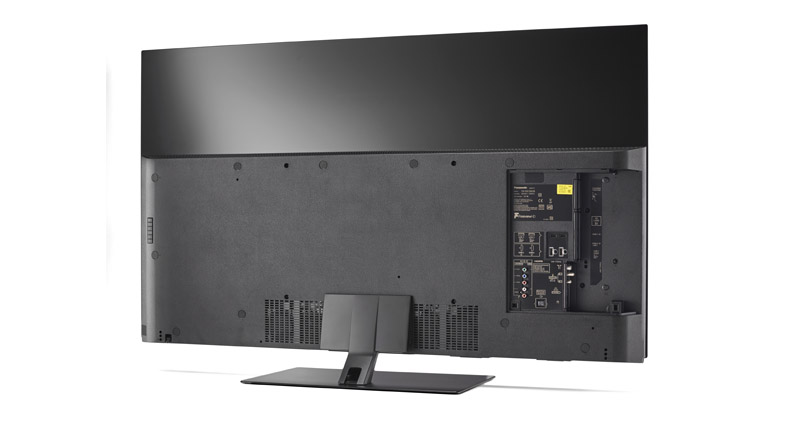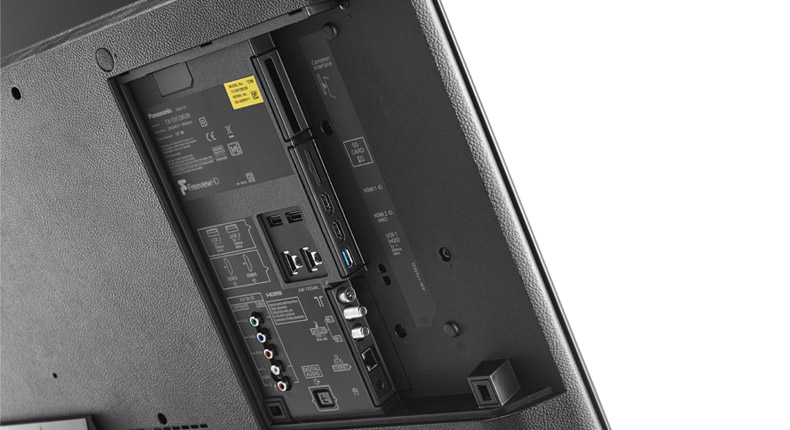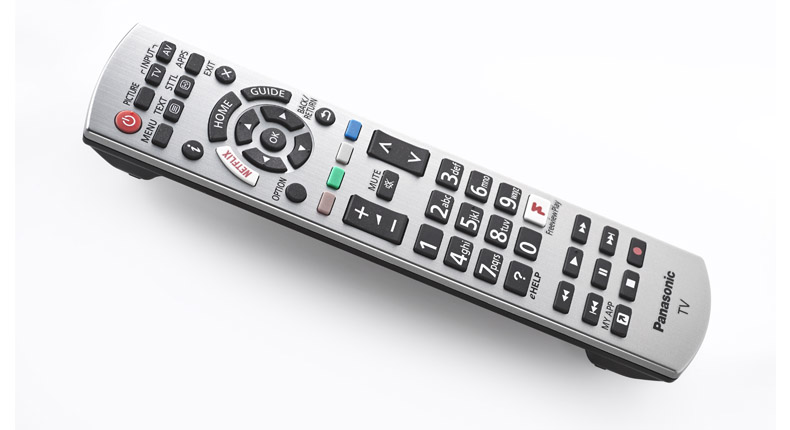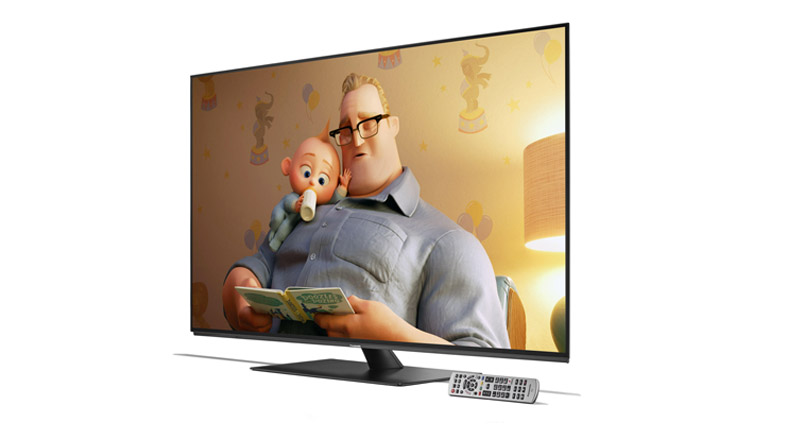What Hi-Fi? Verdict
Not only does Panasonic’s new OLED do justice to HDR, it offers an incredibly LG-like performance at a fraction of the cost
Pros
- +
Perfect blacks combine with bright whites and vibrant colours
- +
Loads of detail
- +
Excellent upscaling
Cons
- -
Lacks the edge definition of some rivals
- -
Operating system
Why you can trust What Hi-Fi?
It’s fair to say we were disappointed by Panasonic’s OLED efforts last year. The TX-55EZ952B was an accomplished performer, but its lack of punch and dynamism - particularly when displaying HDR content - meant four stars was the best it could manage.
Now, just over a year later, the TX-55FZ802B is on the hunt for that fifth star. If you have already seen the rating, you may surmise this is a significantly punchier performer than its predecessors.
In fact, it’s one of the best OLEDs around, offering a remarkably LG C8-like performance at a lower price.
Build

This one of the most stylish TVs Panasonic has produced in ages, albeit in an understated fashion. The panel itself is incredibly thin, even by OLED standards.
The plastic appendage, essential for housing the TV’s connections and processing bits and pieces, covers more of the panel’s rear surface area than the equivalent on many other OLEDs, but there’s no denying the impact of the FZ802’s design when viewed in profile - particularly if wall-mounted. Those not wall-mounting will find a pedestal stand that combines solidity and weight with slim elegance.
While it’s abundantly stylish, the matte-black finish, super-slim bezels and lack of aesthetic flourishes make it look rather minimalistic. This is a TV that puts the content first, then vanishes in a room darkened for movie night.
MORE: What is OLED? The tech, the benefits, the best OLED TVs and OLED phones
Features

On the subject of content, the Panasonic offers plenty of ways to access it. There are four HDMI inputs (only two will handle full-fat 4K HDR signals at 50/60 Hz, but that’s a limitation few people will bump up against) and the vast majority of app bases are covered.
Amazon Video and Netflix are both present in full 4K/HDR form, as is BBC iPlayer (during the World Cup, at least). The other UK catch-up services (ITV Hub, All 4, Demand 5) are also present under the Freeview Play banner, enabling fairly seamless access of on-demand content via the main EPG.
Pay-as-you-go access to streaming movies is the Panasonic’s only real weakness on the app front. Google Play Movies & TV, now available on many rival platforms, is missing here, as is Now TV. And while the increasingly common Rakuten is on board, it’s not in 4K HDR as it is via Samsung or LG TVs. Spotify is also missing, but that should be of less concern.
Those who prefer to get their TV the old-fashioned way will be pleased to discover that as well as Freeview there’s also a proper, twin-tuner Freesat service. Gamers, meanwhile, will be kept happy by an input lag we measure at under 22ms.

Everything’s wrapped up in Panasonic’s My Home Screen operating system. Press the Home button on the remote and three coloured circles appear representing TV, Apps and Devices. Click on one and you’re taken to the relevant source(s).
It’s exceedingly simple but also somewhat basic, particularly next to the slick and snazzy operating systems offered by LG and Samsung. There’s also a slight pause every time you press the Home button, which becomes quite irritating over time. The Apps portion is a pain too, lacking an obvious search function.
You can add Apps to the main home screen, so if you take the time to track down your favourites at the start they will be far easier and quicker to access later on.
The remote is the same core design Panasonic has been shipping with its TVs for years. It’s simple and responsive (that Home delay notwithstanding), but it’s also rather plasticky, cluttered and unintuitively laid out.
There are useful shortcuts for Netflix and Freeview Play (other apps are accessed via the Apps shortcut button), but no voice control. For a snazzier, more feature-packed remote, you’d need to spend extra on the FZ802’s brother, the FZ952.
Picture

What’s most remarkable about the Panasonic’s picture performance – beyond it being simply excellent – is how similar it is to that of the LG OLED55C8 PLA.
That may not initially sound remarkable at all – the two TVs use the latest generation LG-manufactured OLED panel, after all. But while a certain degree of core similarity should be expected, the panel is just one ingredient that influences performance. Last year’s Panasonic OLEDs were different to LG’s own models, for example, and Sony OLEDs have their own unique picture characteristics.
All of which makes the fact these two tellies look like siblings from the same manufacturer rather surprising. It also makes the Panasonic FZ802 an extremely accomplished performer.
Our biggest issue with Panasonic’s OLEDs last year was their lack of brightness and vibrancy with HDR content. However, it immediately becomes clear the FZ802 doesn’t suffer the same flaw.
A good backlit TV, particularly a high-end screen such as the Samsung Q9FN, will go brighter, but for an OLED this is right up there. Add OLED’s pure blacks and you’ve genuinely stunning contrast.
Colours are superb, too: rich, vibrant and vivid, but perfectly judged to deliver natural scenery and realistic skin tones.
MORE: HDR TV - What is it? How can you get it?

All of these strengths are illustrated clearly and concisely in the ‘space chase’ chapter of the Guardians of the Galaxy Vol. 2 on 4K Blu-ray disc.
Shots outside Starlord’s ship show a vista combining the inky blackness of deep space with brightly twinkling stars and gorgeously coloured nebulae, while shots within the cockpit illustrate subtlety and realism in the recreation of the skin and fur of the Guardians themselves. There’s nothing here that stands out in a negative way or suggests any level of error. It’s natural, believable and captivating.
The Panasonic’s motion processing is pretty good, too. There’s a fair bit of soap opera-like weirdness when the Intelligent Frame Creation is on its higher settings, but at its minimum there’s a little bit of sharpening and smoothing without an abundance of unnatural shimmer. The best Sony TVs are better with motion, but the FZ802 is certainly a match for its rivals from Samsung and LG.
Move down from 4K HDR to 1080p and even standard-def, and the Panasonic continues to put in a performance that’s strikingly similar to that of the LG C8. Again the natural, controlled colours are most notable, but detail levels are excellent too, and the cleanliness and clarity of the image - even when the TV is having to work extra hard with a low quality signal - is impressive.
But while the pictures produced by the Panasonic are similar to those of the LG, they’re not identical - and the LG has the slight edge. Compared to the C8, the FZ802 is slightly lacking sharpness and definition, and the result is a marginally softer, flatter image. There’s really not much in it, but the LG pops from the screen that bit more effectively, and you see it in all elements of the image, from objects to characters to clouds.
The LG also goes just a touch brighter. There’s an even smaller margin here, but there’s a smidge greater purity and punch to the brightest elements, particularly when watching HDR.
MORE: 4K Ultra HD Blu-ray – all the 4K discs on sale and coming soon
Sound
Panasonic makes no great claims for the speakers of the FZ802 – if you’re after a superior, built-in sound solution, they’d prefer you to fork out the extra for the FZ952 and its integrated soundbar.
So it’s a pleasant surprise the practically invisible drivers of the cheaper model provide decent delivery by prevailing standards. Bass weight and depth is lacking, but the delivery is open, spacious and well projected, with direct, clear voices.
Of course, you can improve upon it with a soundbar – and without spending a huge amount of money either – but if you’re determined to use your new TV’s built-in speakers, the Panasonic will do the job surprisingly well.
MORE: Best soundbar and soundbase deals
Verdict
So, if the Panasonic TX-55FZ802B is so similar to the LG OLED55C8PLA, why would you buy the former over the latter? The price, that’s why.
The Panasonic is available for £500 less than the LG with which it shares a panel, and that makes it a tempting choice.
On the other hand, the LG’s greater edge definition and resulting three-dimensionality, plus slightly brighter whites and a snazzier, more fully featured operating system, are arguably worth the extra outlay.
Much will depend on how prices shake out over the coming weeks and months, but in its own right the Panasonic FZ802 is a superb television - and a real return to form for Panasonic.
See all our Panasonic reviews
What Hi-Fi?, founded in 1976, is the world's leading independent guide to buying and owning hi-fi and home entertainment products. Our comprehensive tests help you buy the very best for your money, with our advice sections giving you step-by-step information on how to get even more from your music and movies. Everything is tested by our dedicated team of in-house reviewers in our custom-built test rooms in London, Reading and Bath. Our coveted five-star rating and Awards are recognised all over the world as the ultimate seal of approval, so you can buy with absolute confidence.

